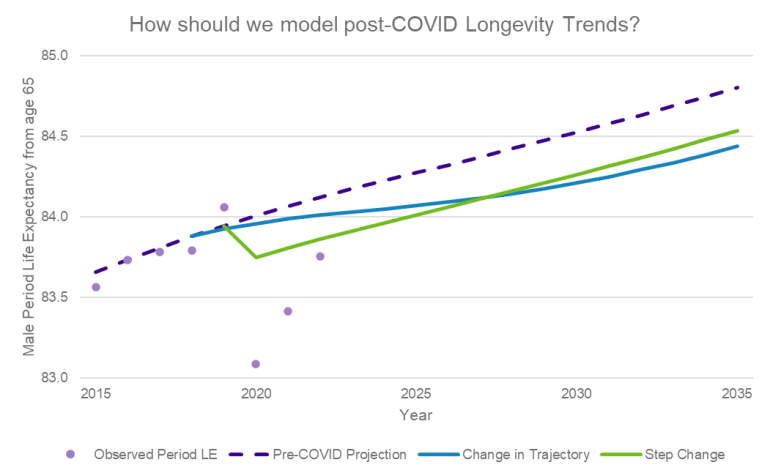Question:
What is the best way to capture the impact of the COVID-19 pandemic in longevity projections?
Answer:
It will take a few more years of data to come through before we can confidently define the post-COVID longevity landscape. What we do know is that we are very unlikely to return to the pre-COVID life expectancy trajectory in the short-to-medium term. This is because of the long-lasting impact of COVID on individual health (for example Long COVID) and on healthcare systems, alongside the additional unanticipated headwinds associated with high inflation, low economic growth and the resulting pressures on living standards. (More details on this in our recent webinar recording “What happened in 2022 and will it continue?”).
At Club Vita we are starting to see two broad schools of thought emerge as to how to model post-COVID trends. We have categorised these as “Change in Trajectory” and “Step Change”. The Change in Trajectory approach allows for a lower rate of increase in life expectancy than was anticipated pre-pandemic over the remainder of this decade. This is the approach which will be adopted by the CMI in their CMI_2022 Mortality Projections Model. In contrast, the Step Change approach retains the pre-pandemic trajectory, but assumes that life expectancy in the immediate aftermath of COVID will be considerably lower than we expected pre-pandemic. These two approaches are exemplified in the chart below.

Source: Club Vita calculations based on the CMI’s illustrative software published alongside Working Paper 168. Observed period life expectancies estimated using England & Wales data for men. The blue line shows the proposed core projection methodology for CMI_2022 with long term rate of 1.5% pa. The purple and green lines show projections with W2022 set to zero. The step change in green line modelled via a 103.5% scaling factor, equating broadly to a 3-month loss in life expectancy from age 65.
In practice, a combination of these two approaches could also be used. Importantly, care is needed is not to double count the impact of COVID by allowing for it both in your current estimate of life expectancy and in your projection (for example by shifting the blue line down to sit closer to the observed life expectancy seen in 2022).
There may also be an argument that the lost years of improvement due to the pandemic and the cost-of-living crisis may be subject to a period of catch-up once economic conditions have improved later in this decade or at the start of the 2030s. Neither approach illustrated above allows for the possibility of a medium-term rebound.
Relative to the pre-COVID projection, adopting the Change in Trajectory projection will have a bigger impact on overall life expectancy for a current 65-year-old man. It would lead to still larger reductions for younger lives. The opposite is true for older lives (those in their late 70s or older), where the Step Change approach would lead to a larger reduction in life expectancy. This means that for all but the most mature groups of lives, adopting the Change in Trajectory approach would lead to a bigger reduction in liabilities. (We note that this comparison depends on the size of the “step” assumed in the Step Change scenario.)
Key takeaways:
- It will be a couple more years before we can confidently say where life expectancies have landed post-COVID.
- In the absence of that data, we are seeing two schools of thought emerging on how to model the post-COVID period:
- Change in Trajectory – improvements in life expectancy will be lower during the 2020s than predicted pre-COVID.
- Step Change – improvements in life expectancy post-COVID will be similar to pre-COVID expectations but from a lower starting point.
- Whichever approach you adopt, it is important to consider the setting of base tables and improvement tables holistically to avoid the risk of double counting the impact of COVID.
- Those charged with managing longevity risk should also consider the possibility of a period of elevated improvements as the various challenges in healthcare and economic conditions are resolved. Neither approach as illustrated above allows for such a bounce back.
The key question is:
- What approach will better describe the trajectory of longevity in the future, a Change in Trajectory, a Step Change, a combination of the two, or something different?




